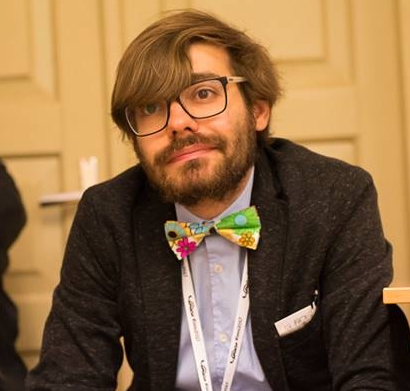
Title: A semiotic concept of technology
Speaker: Dr. Alin Olteanu
Abstract
I propose defining technology from a semiotic perspective and discuss the consequences thereof for construing language. By adopting semiotic modelling theory (Sebeok, Danesi 2000) and in inspiration of the postdigital view on mind (Fuller 2022), I define technology as the mind’s outworking. This implies that language is one among many technologies that humans use to construct meaningful environments. Through this exploration, I aim to usher the uptake of the concept of multimodality in the current discussion on mind-technology continuity (Clowes et al., 2021). This has important implications for how to conceive data, in general, and language data, in particular.
Modern (Western) academia has been dominated by the interrogation of meaning as dependent to language, understood as a specific human capacity. In this optics, inferring and critical thinking have been deemed linguistic competences. This is due to the centrality of the printing press in ushering the European Enlightenment, its educational program and, alongside these, colonialism (Anderson 2006 [1983]; Hartley 2012).
While the confusion of critical thinking with language competences has been exposed and undermined by research in the last decades, for instance, in cognitive sciences and evolutionary linguistics, it is difficult to uproot it entirely from academic discourse, as it is central to academic and folk metalanguages.
Dislocating the centrality of print technology and, with it, of language from social representations, newly emerging technologies are revealing the fallacies of language-centric discourses, both in academia and in society, broadly. The varieties of contemporary media, and the heterogenous representations they yield, offer vantage points from where to observe the fallacy of conflating print technology and critical thinking in research and education. In brief, the current technological moment is revealing that thought, including critical thinking, unfolds in a complexity of sense perception channels and meaning modalities. As argued in cognitive semiotics, inference is perceptive (Paolucci, 2021). This also constitutes the thesis of multimodality (Kress, van Leuween 2001). It illustrates that language itself is a heterogenous and multimodal modelling system, among other modelling systems employed by humans to construct meaningful worlds. As such, particularly amid the media changes of this technological revolution, academia and education need to be reconsidered through the prism of argumentation as multimodal, namely what is called multimodal critical discourse analysis (Bouvier, Machin 2018). Unlike language-centric theories that dissociate content and form, multimodal analysis posits that technologies shape (discursive) content.
The challenge in rethinking academia multimodally consists in having to observe the change from within, as it unfolds. McLuhan (1994 [1964]) described this as Narcissus narcosis, meaning that media extensions produce numbness: in observing technological emergence, the observer misses that it is observing itself. This begs the question of what are we observing when we are observing (language) data in new, digital media?
I argue that multimodal critical discourse analysis can be further developed by adopting a concept of technology as the mind’s outworking, namely the mind’s work to expand inter-medially. Also, multimodal critical discourse analysis helps unravel the language-centric assumptions of other recent attempts to define language as technology (Dor, 2015) and, thus, can reveal new pathways for science and technology studies.
References
Anderson, B. 2006 [1983]. Imagined communities: Reflections on the origin and spread of nationalism. Verso.
Bouvier, G., Machin, D. 2018 Critical Discourse Analysis and the challenges and opportunities of social media. Review of Communication 18(3): 178-192.
Clowes, R. W., Klaus, G., Hipolito, I. Eds. 2021. The mind-technology problem: Investigating selves, minds and 21st century artefacts. Springer.
Dor, D. 2015. The instruction of imagination: Language as a social communication technology. Oxford University Press.
Fuller, S. 2022. The mind-technology problem. Postdigital Science and Education 4: 247–252.
Hartley, J. 2012. Digital Futures for cultural and media studies. Wiley-Blackwell.
Kress, G., van Leeuwen, T. 2001. Multimodal Discourse: The Modes and Media of Contemporary Communication. Arnold.
McLuhan, M. 1994 [1964]. Understanding Media: The Extensions of Man. The MIT Press.
Paolucci, C. 2021. Cognitive semiotics: Integrating signs, minds, meaning, and cognition. Springer.
Sebeok, T.A., Danesi, M. 2000. The forms of meaning: Modelling systems theory and semiotic analysis. Mouton d Gruyter.
Date: 2023-12-06
Time: 15:30-17:00
Venue: 136 # of ICSA, SHISU
Organizer: Institute of Corpus Studies and Applications (ICSA)


 Back
Back

 Office Hour: 9:00-17:00
Office Hour: 9:00-17:00 Office: +86-21-67705180
Office: +86-21-67705180 Email: 2020215@shisu.edu.cn
Email: 2020215@shisu.edu.cn







